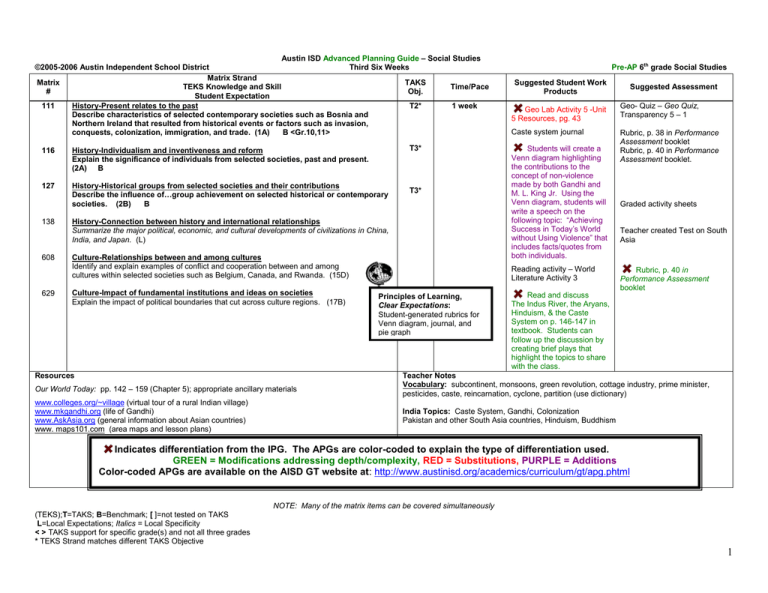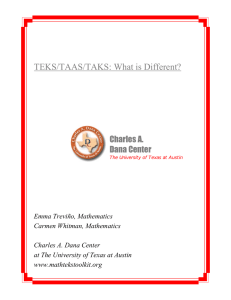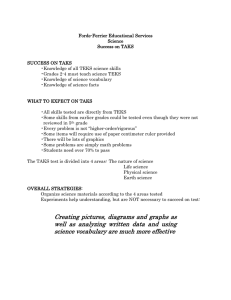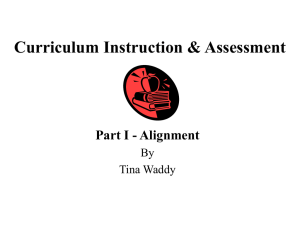Document 15362193
advertisement

Austin ISD Advanced Planning Guide – Social Studies ©2005-2006 Austin Independent School District Third Six Weeks Matrix Strand Matrix TAKS TEKS Knowledge and Skill Time/Pace # Obj. Student Expectation 111 History-Present relates to the past T2* 1 week Describe characteristics of selected contemporary societies such as Bosnia and Northern Ireland that resulted from historical events or factors such as invasion, conquests, colonization, immigration, and trade. (1A) B <Gr.10,11> T3* 116 History-Individualism and inventiveness and reform Explain the significance of individuals from selected societies, past and present. (2A) B 127 History-Historical groups from selected societies and their contributions Describe the influence of…group achievement on selected historical or contemporary societies. (2B) B 138 608 629 T3* History-Connection between history and international relationships Summarize the major political, economic, and cultural developments of civilizations in China, India, and Japan. (L) Culture-Relationships between and among cultures Identify and explain examples of conflict and cooperation between and among cultures within selected societies such as Belgium, Canada, and Rwanda. (15D) Culture-Impact of fundamental institutions and ideas on societies Explain the impact of political boundaries that cut across culture regions. (17B) Resources Pre-AP 6th grade Social Studies Suggested Student Work Products Geo Lab Activity 5 -Unit 5 Resources, pg. 43 Caste system journal Students will create a Venn diagram highlighting the contributions to the concept of non-violence made by both Gandhi and M. L. King Jr. Using the Venn diagram, students will write a speech on the following topic: “Achieving Success in Today’s World without Using Violence” that includes facts/quotes from both individuals. Reading activity – World Literature Activity 3 Principles of Learning, Clear Expectations: Student-generated rubrics for Venn diagram, journal, and pie graph Suggested Assessment Geo- Quiz – Geo Quiz, Transparency 5 – 1 Rubric, p. 38 in Performance Assessment booklet Rubric, p. 40 in Performance Assessment booklet. Graded activity sheets Teacher created Test on South Asia Rubric, p. 40 in Performance Assessment booklet Read and discuss The Indus River, the Aryans, Hinduism, & the Caste System on p. 146-147 in textbook. Students can follow up the discussion by creating brief plays that highlight the topics to share with the class. Our World Today: pp. 142 – 159 (Chapter 5); appropriate ancillary materials Teacher Notes Vocabulary: subcontinent, monsoons, green revolution, cottage industry, prime minister, pesticides, caste, reincarnation, cyclone, partition (use dictionary) www.colleges.org/~village (virtual tour of a rural Indian village) www.mkgandhi.org (life of Gandhi) www.AskAsia.org (general information about Asian countries) www. maps101.com (area maps and lesson plans) India Topics: Caste System, Gandhi, Colonization Pakistan and other South Asia countries, Hinduism, Buddhism Indicates differentiation from the IPG. The APGs are color-coded to explain the type of differentiation used. GREEN = Modifications addressing depth/complexity, RED = Substitutions, PURPLE = Additions Color-coded APGs are available on the AISD GT website at: http://www.austinisd.org/academics/curriculum/gt/apg.phtml NOTE: Many of the matrix items can be covered simultaneously (TEKS);T=TAKS; B=Benchmark; [ ]=not tested on TAKS L=Local Expectations; Italics = Local Specificity < > TAKS support for specific grade(s) and not all three grades * TEKS Strand matches different TAKS Objective 1 Austin ISD Advanced Planning Guide – Social Studies ©2005-2006 Austin Independent School District Third Six Weeks Matrix Strand Matrix TAKS TEKS Knowledge and Skill Time/Pace # Obj. Student Expectation 112 History-Present relates to the past T1 5 weeks Analyze the historical background of selected contemporary societies to evaluate relationships between past conflicts and current conditions, such as those in Southwest Asia and North Africa, North and South Korea, and South Africa . (1B) B <Gr.10, 11> 201 214 219 223 224 Geography-Concept of location Locate major historical and contemporary societies on maps and globes. Pre-AP 6th grade Social Studies Suggested Student Work Products Suggested Assessment Critical Thinking Skills, Activity 6, p. 65 – 66 “Recognizing Stereotypes” T2 (4A) B Geography-Translate and analyze geographic data Pose and answer questions about geographic distributions and patterns for selected world regions and countries shown on maps, graphs, charts, models, and databases. (3B) B T2 Geography-One area is similar to, and different from, another area Compare selected world regions and countries using data from maps, graphs, charts, databases, and models. (3C) B T2 Geography-Humans have adapted to, and modified, the physical environment Identify and analyze ways people have adapted to the physical environment in selected places and regions. (7A) B T5* Geography-Humans have adapted to, and modified, the physical environment Identify and analyze ways people have modified the physical environment, such as the Amazon River Basin, the Aswan and Three Gorges Dams, and the Nile River Valley. (7B) B <WG.8.G> T5* 138 History-Connection between history and international relationships Summarize the major political, economic, and cultural developments of civilizations in China, India and Japan. (L) 158 History-Historical development of political issues Identify examples of world superpowers, such as the United States, Russia, China and Japan. (L) 222 Geography-Humans rely on natural resources Describe and explain the physical processes that produce renewable and nonrenewable natural resources such as fossil fuels, fertile soils, and timber. (6B) Create physical, political and thematic maps of China, Mongolia, and Taiwan Graded Activity Sheets Time Reports (Our World Today, p. 174) Create an illustrated timeline of ancient Chinese dynasties and their accomplishments. Compare this with a timeline from another region of the world, such as Egypt, and formulate hypotheses about the reasons and/or causes for the rise and fall of each culture and about the impact these cultures have on today’s American society. Map rubric: See p. 42 in the Performance Assessment Booklet. Criteria chart for timeline. . History Alive: Activity 2 Designing Character Collages of Buddha, Confucius, and Laozi NOTE: Many of the matrix items can be covered simultaneously (TEKS);T=TAKS; B=Benchmark; [ ]=not tested on TAKS L=Local Expectations; Italics = Local Specificity < > TAKS support for specific grade(s) and not all three grades * TEKS Strand matches different TAKS Objective 2 Austin ISD Advanced Planning Guide – Social Studies ©2005-2006 Austin Independent School District Third Six Weeks Matrix Strand Matrix TAKS TEKS Knowledge and Skill Time/Pace # Obj. Student Expectation 227 Geography-Location and patterns of settlement in different areas of the world T2 5 weeks Identify and explain the geographic factors, such as climate, land use, vegetation and (continued) water resources responsible for patterns of population in places and regions. (4B) B 314 Economics-Free enterprise system Identify and differentiate among traditional, market, and command economics in selected contemporary societies, including the benefits of the U.S. free enterprise system. (8B) B T3 321 Economics-Problems encountered by different societies Identify problems and issues that may arise when one or more of the factors of production is in relatively short supply, such as overdependence on other nations or trade deficits. (9B) B T3 415 Government-Comparisons between different types of governments Compare limited and unlimited governments. (11D) B <Gr.8.16D> T3 403 Government-Role, selection, and responsibilities of authority figures Identify national government officials of contemporary societies. (L) 407 Government-Structure of governments Describe the structure and functions of different types of selected governments in different regions of the world. (L) 511 Citizenship-Characteristics of good citizenship Explain the importance of personal responsibilities such as accepting responsibility for one’s behavior and supporting one’s family. (L) Pre-AP 6th grade Social Studies Suggested Student Work Products Suggested Assessment Physical, political, thematic maps of Japan and Korea Rubric for map on p. 42 in Performance Assessment Booklet. Our World Today, TE, p. f193, Create a Display – “Life in the Ring of Fire” Rubric for display on p. 36 of Performance Assessment Booklet. History Alive! China and Japan, Activity 5 - Land and Population: An insight into the Effects of Geography on Japanese Culture NOTE: Many of the matrix items can be covered simultaneously (TEKS);T=TAKS; B=Benchmark; [ ]=not tested on TAKS L=Local Expectations; Italics = Local Specificity < > TAKS support for specific grade(s) and not all three grades * TEKS Strand matches different TAKS Objective 3 Austin ISD Advanced Planning Guide – Social Studies ©2005-2006 Austin Independent School District Third Six Weeks Matrix Strand Matrix TAKS TEKS Knowledge and Skill Time/Pace # Obj. Student Expectation 611 Culture-How cultures change over time T3* 5 weeks Relate ways in which contemporary expressions of culture have been influenced by (continued) the past. (18B) B 711 Science, Technology & Society-Impact of technology on cultural development Explain how resources, belief systems, economic factors, and political decisions have affected the use of technology from place to place, culture to culture, and society to society. (20B) B 523 Citizenship-Individual and group participation in the democratic process Explain how opportunities for citizens to participate in and influence the political process vary among selected contemporary societies. (13B) 605 621 622 629 T2* Culture-How people learn about themselves Explain the significance of religious holidays and observances such as Christmas and Easter, Ramadan, and Yom Kippur and Rosh Hashanah in selected contemporary societies. (19B) Culture-Relationship between art and literature and societies Explain the relationships that exist between societies and their architecture, art, music, and literature. (18A) Culture-Relationship between art and literature and societies Describe ways in which societal issues influence creative expressions. Culture-Impact of fundamental institutions and ideas on societies Explain the impact of political boundaries that cut across culture regions. (18C) (17B) 630 Culture-Impact of fundamental institutions and ideas on societies Identify institutions basic to all societies, including government, economic, educational, and religious institutions. (16A) 814 Social Studies Skills-Use appropriate mathematical skills Use appropriate mathematical skills to interpret social studies information such as maps and graphs. (21F) Pre-AP 6th grade Social Studies Suggested Student Work Products “Three Gorges Dam” article, Our World Today, p. 167; “Making Connections”, 1-3 Suggested Assessment Graded activity sheets. Time Reports: Focus on World Issues – “Will Good Times Set China Free?” Our World Today, TE, pp. 173178 “Silk Road” lesson plan activities (see attached lesson plan) Test on China and Its Neighbors, Japan and the Koreas History Alive!, “China and Japan” Activity 3: Encountering Traditions in Modern Chinese Family Life History Alive!, “China and Japan” Activity 4: Writing Journals About Life in a Chinese Village History Alive!, “China and Japan” Activity7: The Student Perspective : Reporting on Japanese Education Can Korea be Reunited? Essay or Debate (see complete lesson description in Teacher Notes section, along with an attachment at the end of the APG document.) Principles of Learning, Accountable Talk: Critical Thinking Activity, p. 176, Time Reports Student created Rubric NOTE: Many of the matrix items can be covered simultaneously (TEKS);T=TAKS; B=Benchmark; [ ]=not tested on TAKS L=Local Expectations; Italics = Local Specificity < > TAKS support for specific grade(s) and not all three grades * TEKS Strand matches different TAKS Objective 4 ©2005-2006 Austin Independent School District Matrix Strand Matrix TEKS Knowledge and Skill # Student Expectation Resources Our World Today: p. 160 – 207 (chapters 6 and 7) Our World Today: Ancillary materials Austin ISD Advanced Planning Guide – Social Studies Third Six Weeks Suggested resource: History Alive!, “China and Japan”, Activities 2, 3, 5, and 7 6 Weeks Available Resources Men of Our Time: Gandhi (38:03) Destiny Determined: Power and Ritual in Asia (54:00) Stories from China: Land and People (25:00) Landmarks of Civilization: The Great Wall of China (8:29) Religions of the World: Buddhism (28:10) TAKS Obj. Time/Pace Pre-AP 6th grade Social Studies Suggested Student Work Products Suggested Assessment Teacher Notes Vocabulary: fault, communist state, free enterprise system, invest, consumer goods, “one country – two systems” pledge, dynasty, human rights, exile, pagodas, technology industries, empire, nomads, steppes, yurts, tsunamis, archipelago, intensive cultivation, clans, samurai, constitutional monarchy, megalopolis, dynasties, monsoon, famines Uniting Forces & Dividing Forces China: Basic Geography, History: Great Wall, Dynasties, Silk Road, contemporary religion, communist government, economics, market economy Japan: Basic Geography, History, feudalism, World War II (Pearl Harbor, atomic bomb), contemporary religion, government, economics Koreas and Southeast Asia: Basic Geography, Korea: division and conflict Southeast Asia: mainland and islands Can Korea be Reunited? Begin by discussing the definitions of Uniting Forces and Dividing Forces. Students should research possible reasons for both forces using the following topics: -Language - History -Religion - Economy -Government - Physical Geography -Core Area Celebrate Freedom Week: House Bill 1776 requires that students in the state of Texas recite and study the following text from the Declaration of Independence during Celebrate Freedom Week, the week of November 11: “WE hold these Truths to be self-evident, that all Men are created equal, that they are endowed by their Creator with certain unalienable Rights, that among these are Life, Liberty and the Pursuit of Happiness. That to secure these Rights, Governments are instituted among Men, deriving their just Powers from the Consent of the Governed . . .” Sample lessons may be found of the following web sites: http://www.tea.state.tx.us/ssc/whatsnew/freedom/hb1776_text.htm http://www.texaslre.org/ Example for Language: The fact that practically everyone in France speaks the French language ties the French people and their country together. Indonesians, however, speak about 250 different languages and this is a factor that tends to divide the Indonesian people. (adapted from Geography for Life Activities, Holt, Rinehart and Winston.) Students can work in groups to fill in the information data chart on North and South Korea (see attachment). This information can be found using the textbook, the internet, and other reference materials. Once the data is complete, students can write an essay or a debate explaining their decision fully, “Can Korea be Reunited?” NOTE: Many of the matrix items can be covered simultaneously (TEKS);T=TAKS; B=Benchmark; [ ]=not tested on TAKS L=Local Expectations; Italics = Local Specificity < > TAKS support for specific grade(s) and not all three grades * TEKS Strand matches different TAKS Objective 5


